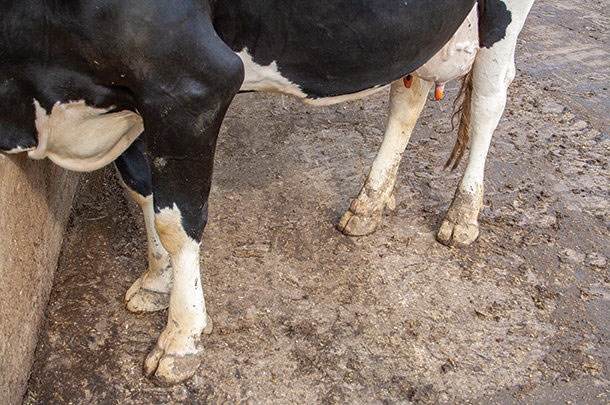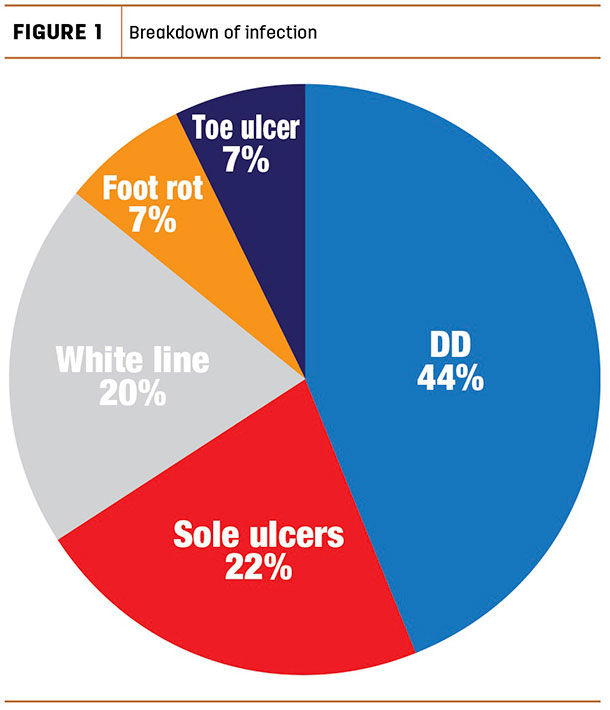Cover the Bases on Foot Health

Our cows have so many demands on them: Put clean milk in the tank, breed back, efficiently utilize feed and more.
However, each of these demands are contingent upon the cow’s mobility. Sometimes it can be difficult to observe the negative impacts of lameness on your own farm.
As the producer, you are there every day.
Sudden lameness can stand out, but other cows progressively decline and it is harder to assess the impact of sore feet.
Can you put a number to your herd foot health?
It’s said that tiestalls have a lameness prevalence of 23%, while freestalls fall to 20% in Canada. As mentioned, hoof diseases affect animals at different levels. Yet any sort of soreness has an impact on production, longevity, fertility, herd profitability and customer perception of animal health and well-being.
If we want to place a number on the impact of lameness, some studies have shown 360- to 400-kilogram decreases in milk per lame cow, per lactation.
Identify the problem
When it comes to dairy cow foot health, there are a few diseases that cause most of the lameness problems. Of all diseases, digital dermatitis (DD) represents about 44% of infections. Also contributing to hoof disease are sole ulcers (approximately 22%), white-line disease (20%), foot rot (7%) and toe ulcers (7%) (Figure 1).

Even before we determine the exact disease, we need to define the percentage of lame cows in the herd by using the locomotion scoring protocol. This will provide the percentage of cows struggling with their feet and rate the severity of the problem.
Scoring cows could be difficult when we are not familiar with the method, or when we see the cows each day and can easily attach a reason to the issue. If we ask a professional to score the cows, we get a true, unbiased evaluation of the locomotion score.
A trained adviser who uses an established protocol to evaluate lameness can see three to four more cases of lameness than an untrained person. The key is to not only do a first evaluation but to then follow up with another stringent look at locomotion scores a few months after the first evaluation.
Early detection and rapid intervention will prevent lameness from worsening and improve the chances of healing the hoof. The more detection and action on-farm, the more the producer is aware of the situation and can implement good practices on-farm.
Remember to include heifers in lameness detection. Be proactive on foot health protocols Risk factors for DD include wet floor, too much manure in the alley, anaerobic condition at hoof level (dirty hoof), infected animals contaminating other cows and poor hoof management (trimming).
Stress in general reduces a cow’s ability to fight against DD.
To combat these issues, there are five areas on which to focus for good hoof health:
- Footbath routine You can measure hygiene score on your farm using a scale of 1 to 4. When you score hygiene, you need to look at their hoof, legs and limbs. A score of 1 is ideal and correlates to “very clean,” whereas 4 exemplifies “dirty.” Depending on your average hygiene score, you may run only one footbath per week or as frequent as daily footbaths (not all footbaths would necessarily be chemical). No matter the footbath chemical, it’s the concentration of solution that solves problems. Higher concentration versus what’s recommended is not necessarily better. We recommend at least 3 to 4 inches of solution from the beginning to the end. The length of the footbath should be 10 to 12 feet. Another consideration is the number of passages. We want to make sure we are not exceeding 200 passages through the footbath before it becomes too diluted. If it’s feasible at your dairy, don’t forget to pass dry cows and heifers through the bath. This will help to prevent disease before the coming lactation. A heifer affected by DD is eight times more likely to have DD re-occur in first lactation, translating to a milk loss of 305 kilograms in first lactation.
- Scraper and manure cleaning Try to keep alleys as clean as possible. Ensure scraper blades are working efficiently. (Sometimes they need adjustments to really dry off the alleys; adjust every three to six months.) Consider increasing the frequency of the alley cleaning to ensure buildup is managed. Decreasing stocking density can also play a part in ensuring clean alleys. Another important piece is increasing grip. Either grooving the floor or adding rubber can help minimize slips.
- Hoof trimming There is no better time to hoof trim than just before dry-off. This timing ensures we are not negatively affecting milk production and minimizing stress before parturition. Reviewing early-lactation cows (80 to 100 days in milk) is another good time to review trimming for a successful lactation. A poor hoof trim can make an otherwise “good cow” lame. Maintain records and involve your team to analyze trimming trends.
- Environment Perching cows are not making milk, and they are at risk for sole ulcers. If we avoid overcrowding, we give enough space for all cows to lie down and rest. Other best practices to keep cows off their feet for longer than necessary involve adjusting stall size, ensuring enough bedding is provided for cows to be dry and comfortable, and maintaining good air flow year-round at the stall level.
- Nutrition Beyond the environment, the ration can be another useful tool in proactive hoof health. Talk to your nutritionist about adding some key oligo-element minerals like chelated zinc to improve skin thickness, keratin and immune system function. At a low cost, biotin could also be added to help build a strong foot base. At no cost, tracking prevalence of acidosis could mean the ration needs a re-balance or indicate somewhere along feeding protocols what is formulated is not what is being fed.
Finally, having sufficient feed in the manger with multiple push-ups ensures cows always have feed access and are not standing waiting for feed or sorting through the diet. There are a lot of pieces that contribute to foot health.
Yet, if we are successful at footbaths, trimming, keeping floors clean, looking at environmental factors and being proactive nutritionally, the payoff in milk and breeding from free-moving cows is huge. It all starts with knowing your percentage of lame cows. By knowing the prevalence of hoof health issues, we can act accordingly.
